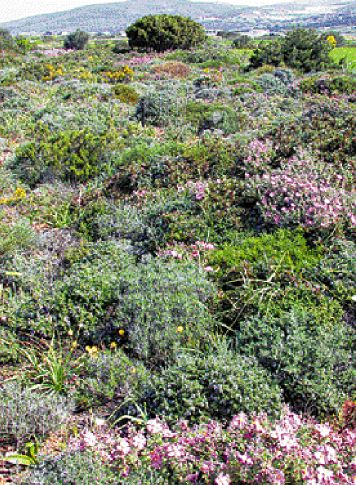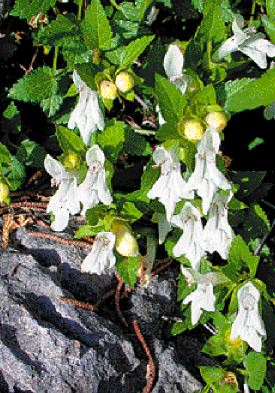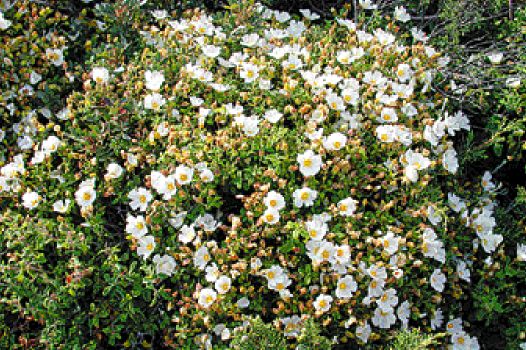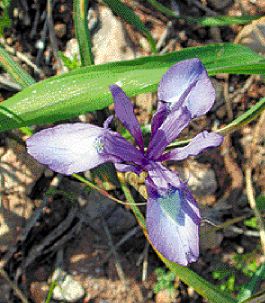 |
||
|
|
||
|
The Heath Hedgehog
Athens News By JENNIFER GAY Prickly phrygana grows wild in thick, aromatic stretches throughout Greece APRIL really is the glory time for Greek phrygana. Usually known as garigue in other parts of the Mediterranean, it is one of the most characteristic habitats of the region. A low-growing plant community commonly found on dry soil, it is composed largely of spiny or aromatic dwarf shrubs - the high proportion of prickles has earned it the name "hedgehog heath". I found this most appropriate when I recently was in Paros: driving back late one night through a wonderful stretch of phrygana, a real hedgehog scuttled across the road in front of me. In many respects, phrygana occupies the same successional position as heathland does in northern Europe. There is quite considerable regional variation in composition, seeming to depend on the type of soils and geology, grazing pressure, the incidence of fires and exposure to sun and wind. |
 Typical Cistus Phrygana |
|
Though botanically speaking there are several forms of phrygana, in layman's terms three main types of phrygana are discernible in Greece. The first is the typical phrygana: low, cushion-forming, spiny aromatic shrubs growing on dry slopes, coastal areas and in abandoned olive groves. Thorny Burnet is one of the dominant plants of this grouping. As shrubs go, it is rather pedestrian; however, Thorny Burnet had an important function in the past - the spiny branches were used for sweeping. In fact many widely used plants find their origin in phrygana, notably culinary herbs. Great swathes of pungently scented Thyme are widely encountered throughout Greece. Flowering later than most phrygana plants, usually in May and June, it makes dramatic drifts of purple on hillsides-already-fading-to-brown. (If you catch it contrasting with a late-flowering Greek Spiny Spurge - the quintessential hedgehog plant - the purple blooms make a wonderful contrast with the limey-green flowers. The spurges all carry these characteristic sharply coloured green and I find them a wonderful companion for purple and pink flowering plants.) |
||
|
Other familiar aromatics belong to this community: Common or Garden Sage is usually found in small groupings though sometimes you see it in huge drifts. Last year in the Inner Mani I saw Sage in full flower growing in profusion through an old olive grove - the bees loved it. Another aromatic, the low-growing silvery Curry Plant, is less frequently seen, but it appears periodically, the silvery leaves covered in a fine down making it well equipped to cope with the midday sun. |
 Prasium majus grows in the shelter of larger shrubs such as Mastic |
|
|
The second type of phrygana is "Cistus phrygana". Common in lowland and coastal areas, it is also often an understorey in open pine woodlands. Cistus are better known as Sun roses, and they are very popular garden plants in northern Europe. They are becoming more widely available here now, but if you want to find some of the unusual ones, try Olivier Filippi's mail order service (Pepiniere Filippi - Plantes Mediterraneennes, Route Nationale 113, Meze 34140, near Montpellier, France. Tel (00 04) 67 43 8869, Fax (00 04) 67 43 84 59. Email: olivier.filippi@wanadoo.fr or see the website www.jardin-sec.com). He has a large nursery in the south of France specialising in native plants but especially Cistus. There are many different kinds of Cistus growing in phrygana, but the two dominant members are Cistus creticus (flowering in pink) and white flowering Sage-leaved Cistus, Cistus salviifolia. Their rather delicate flowers belie their toughness. They are more than capable of taking on coastal winds and salt spray and with only a rocky substrate to anchor themselves in. With the benefit of a garden soil, you will find they grow to twice the size of their usual 50cm; they flower in continuous profusion for a couple of months, their lovely crinkly petals falling each day but replaced by new buds and flowers. They can get a little leggy with age, but you can keep shrubs compact by pinching out stem tips after flowering. |
||
|
|
 Sage-leafed Cistus |
|
|
Typical species |
||
|
Topical tips |
||
|
Flowering now
|
||
(Posting date 27 April 2006) HCS readers can view other excellent articles by this writer in the News & Issues and other sections of our extensive, permanent archives at the URL http://www.helleniccomserve.com./contents.html
All articles of Athens News appearing on HCS have been reprinted with permission. |
||
|
||
|
2000 © Hellenic Communication Service, L.L.C. All Rights Reserved. http://www.HellenicComServe.com |
||


